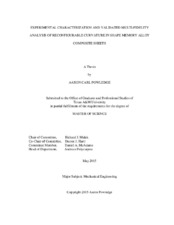| dc.description.abstract | Model validation is often a critically important part of the design process where physics-based models are utilized to explore varying design parameters. Without validating a model with experimental data, it is difficult to determine the usefulness and appropriateness of the model for its intended purposes. This work proposes a framework for validating physics-based models for self-folding laminate structures which employ active materials to achieve deformation. The framework utilizes 3D digital image correlation techniques as a means of capturing physical deformations in physical space to compare to data generated by traditional modeling methods, including finite element analysis simulations and system performance predictions which are based on classical laminate beam theory. Comparisons between models and the physical system are prepared by calculating the mean Hausdorff distance between the three dimensional surfaces, a method proven to be mathematically reliable for shape matching between objects. This distance metric, implemented along with a visualization tool, provides a fast and intuitive means for judging how well the physics-based model approximates the real system, and allows for models of varying fidelity to be easily compared.
Such an assessment effectively facilitates studies of modeling tradeoffs between accuracy and resource cost – a tradeoff must be made at some level for almost every type of system being modeled, to allow for engineers to make an informed design decision. Though this work follows the development of a particular shape memory alloy based self-folding laminate system, the methodology and process described are applicable to other types of systems concerned with a changing surface curvature in the system being simulated. The work also describes details and methods considered for fabrication and testing of the laminate specimens considered herein, creating and implementing the physics based models, and considers the verification and validation of the tool which assesses and compares the experimental and simulated results. | en |


